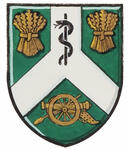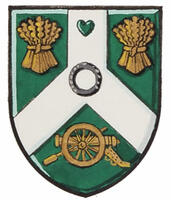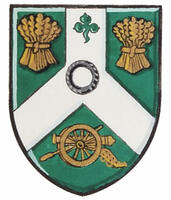The contents of this Register are intended for research purposes only. The heraldic emblems found in the Register may not be reproduced in any form or in any media without the written consent of the Canadian Heraldic Authority and/or the recipient.
Don Mills, Ontario
Grant of Arms, with differences to Peter Raymond Hyde Wilkes, Patricia Jane Hartley and Victoria Heeney Trantor.
July 15, 2003
Vol. IV, p. 296
Arms of John Ballingal WilkesBlazonVert on a pall reversed Argent between in chief two garbs and in base a field gun Or, a ring Sable; SymbolismThe wheatsheaves symbolize the agricultural background of several branches of Mr. Wilkes' family. The iron ring is the symbol of a Canadian engineer, while the inverted white shape suggests a highway, a reference to Mr. Wilkes' long career in planning, designing, constructing, and maintaining highways in Ontario. The field-gun is taken from the badge of the Royal Canadian Artillery and refers to the petitioner's wartime overseas service in the RCA, while its green background recalls the green patch of the 4th Canadian Armoured Division, in which he served. |
CrestBlazonAn eagle's head erased Or gorged with a ribbon Vert pendent therefrom an escutcheon quarterly Gules and Argent; SymbolismThe eagle is derived from the arms of John "Liberty" Wilkes (1725-1797), the famous radical politician and Lord Mayor of London, from whom Mr. Wilkes is descended. The small shield refers to the arms of the Royal Heraldry Society of Canada, of which Mr. Wilkes is a long-time member and Honorary Fellow. |
MottoBlazonLIBERTY AND LOYALTY; SymbolismThe word "Liberty" refers to the eighteenth-century John Wilkes, and it complements the idea of "Loyalty" cherished by Mr. Wilkes, especially in his work for the Canadian Royal Heritage Trust and the Monarchist League of Canada. |
Differenced Arms for Peter Raymond Hyde Wilkes, son of John Ballingal WilkesBlazonThe Arms of John Ballingal Wilkes with a rod of Aesculapius Sable in place of the ring; SymbolismPeter Raymond Hyde Wilkes uses a rod of Aesculapius, a traditional symbol of the medical profession in which he is a practitioner. This is a rod with a single snake entwined around it. This will be a permanent mark of difference to the arms of Dr. Wilkes and his descendants. |
Differenced Arms for Patricia Jane Hartley, daughter of John Ballingal WilkesBlazonThe Arms of John Ballingal Wilkes debruised of a heart Vert in chief; SymbolismPatricia Jane Hartley uses her father's arms with a heart in the main colour of the shield, green, placed at the top centre of the shield. This makes reference to her husband's surname, Hartley, and has been used as a mark of an eldest daughter by the Canadian Heraldic Authority. |
Differenced Arms for Victoria Heeney Trantor, daughter of John Ballingal WilkesBlazonThe Arms of John Ballingal Wilkes debruised of a trefoil slipped Vert in chief; SymbolismVictoria Heeney Wilkes uses the arms with a green trefoil, a heraldic symbol resembling a shamrock or clover, placed at the top centre of the shield. This refers to her mother's Irish heritage, and its trefoil shape indicates that she is the third child. |
Additional InformationCreator(s)Original concept of John Wilkes, assisted by the Heralds of the Canadian Heraldic Authority PainterGordon Macpherson CalligrapherDoris Wionzek Recipient TypeIndividual |









